Peugeot PARTNER 2004 Owner Manual
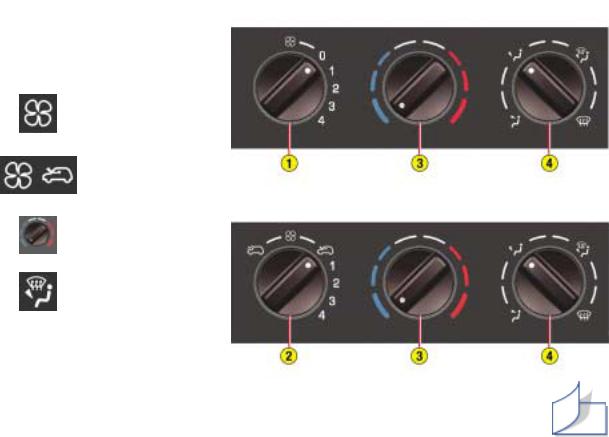
10 |
|
|
YOUR PARTNER AT A GLANCE |
|
|
|
|
|
|
|
HEATING |
|
|
|
|
|
|
|
|
|
N° |
Symbol |
Function |
|
|
|
|
|
|
|
1 |
|
Air flow adjustment. |
|
|
|
|
|
|
|
2 |
|
Air flow adjustment |
|
|
|
and air intake control. |
|
|
|
|
|
|
|
|
|
|
|
|
|
3 |
|
Temperature |
|
|
|
adjustment. |
|
|
|
|
|
|
|
|
|
|
|
|
|
4 |
|
Air distribution |
|
|
|
adjustment. |
|
|
|
|
|
|
|
|
|
|
|
|
48
 22-12-2003
22-12-2003
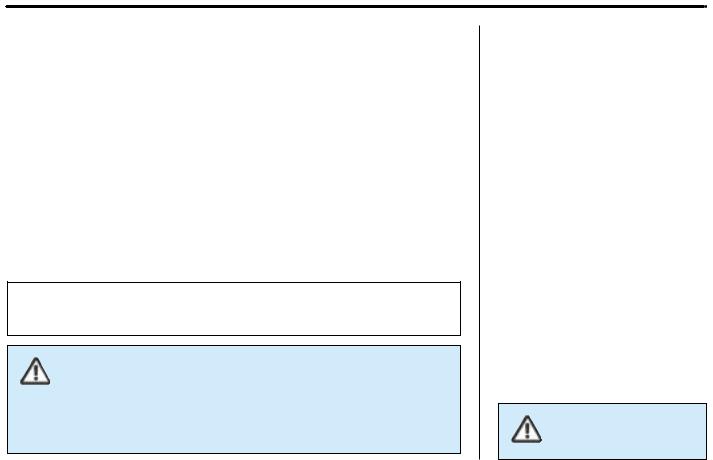
100
PRACTICAL INFORMATION
BATTERY
To charge the battery using a battery charger:
–Disconnect the battery,
–Follow the instructions for use given by the battery charger manufacturer,
–Reconnect starting with the negative (–) terminal,
–Check that the terminals and connectors are clean. If they are covered with sulphate (white or greenish deposit), disconnect them and clean them.
To start the vehicle from another battery:
–Connect the red cable to the positive (+) terminals of the two batteries,
–Connect one end of the green or black cable to the negative (–) terminal of the slave battery,
–Connect the other end of the green or black cable to an earth point on the broken down vehicle as far as possible from the battery.
Operate the starter, let the engine run.
Wait for the engine to return to idle, then disconnect the cables.
It is advisable to disconnect the battery if the vehicle is not to be used for a period of more than one month.
–Never disconnect a terminal when the engine is running.
–Never charge a battery without first disconnecting the terminals.
–After every reconnection of the battery, switch on the ignition and wait 1 minute before starting to allow the electronic systems to be initialised. If slight difficulties are experienced after this, please contact a PEUGEOT dealer.
ECONOMY MODE FUNCTION
After the engine has stopped, with the key in the accessories position, certain functions (windscreen wiper, electric windows, courtesy lights, audio equipment etc.) can only be used for thirty minutes, to prevent discharging the battery.
Once the thirty minutes are over, the message "Eco mode active" appears on the multifunction display and the active functions are put on standby.
A flat battery will prevent the engine from starting.
 22-12-2003
22-12-2003
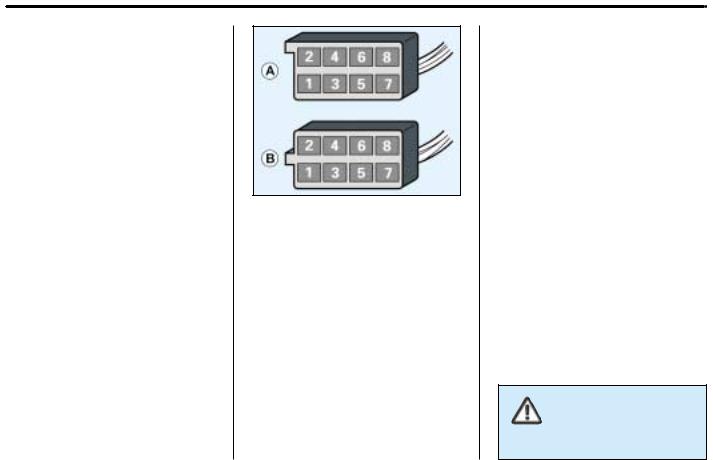
101
PRACTICAL INFORMATION
FITTING AUDIO EQUIPMENT
Your vehicle is equipped with certain factory-fitted audio equipment:
–roof aerial,
–coaxial aerial cable,
–basic interference suppression,
–supply to front speakers,
–two 8-way connectors.
FITTING SPEAKERS
The factory-fitted equipment allows the fitting of 165 mm diameter speakers in the front doors.
Making the connections
A1 : –
A2 : –
A3 : –
A4 : –
A5 : –
A6 : (+ve) Accessories
A7 : (+ve) Permanent
A8 : (–ve) Earth
B1 : (+) –
B2 : (–) –
B3 : (+) Front right speaker
B4 : (–) Front right speaker
B5 : (+) Front left speaker
B6 : (–) Front left speaker
B7 : (+) –
B8 : (–) –
Contact a PEUGEOT dealer before fitting audio equipment or speakers in your vehicle.
 22-12-2003
22-12-2003
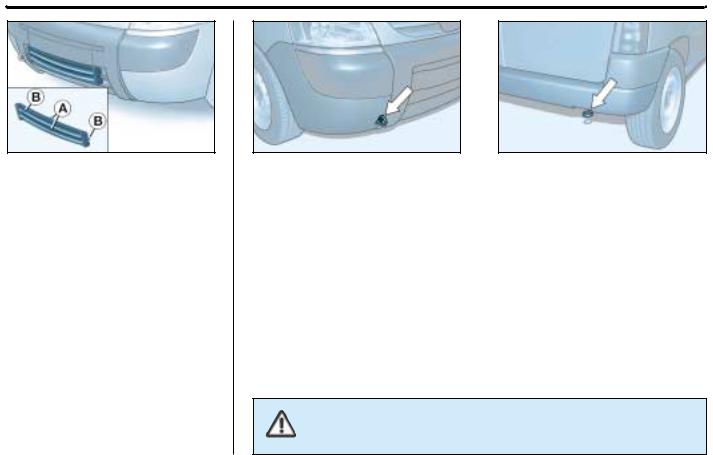
102
PRACTICAL INFORMATION
SNOW SCREEN*
The snow screen is installed on the lower part of the front bumper to prevent the accumulation of snow at the radiator cooling fan.
When the snow has cleared, do not forget to remove the snow screen.
FITTING
Offer up the snow screen facing its centring pin A on the front bumper.
Put it in place by pressing at each clip B located in the four corners.
REMOVAL
Pass a screwdriver into the hole located near each of the clips.
Use the screwdriver as a lever to unclip the four clips B in turn.
* According to destination.
 22-12-2003
22-12-2003
TOWING YOUR VEHICLE
Without lifting (four wheels on the ground)
You must always use a tow bar.
From the front or the rear
Attach the tow bar to the towing eye.
By lifting (two wheels only on the ground)
It is preferable to lift the vehicle by the wheels.
Never use the radiator crossmember.
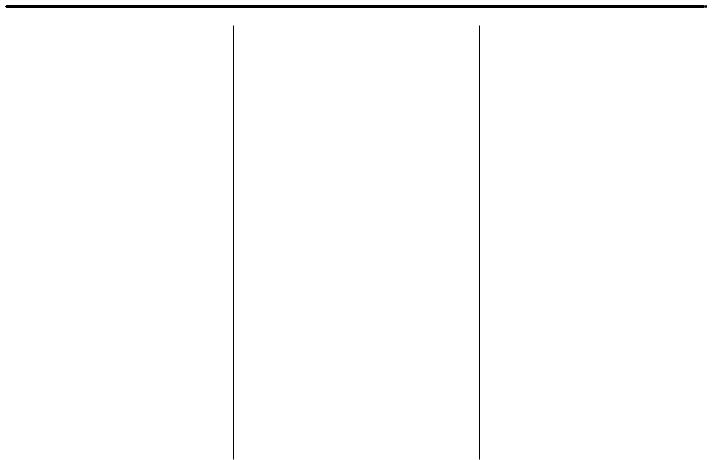
103
PRACTICAL INFORMATION
TOWING A TRAILER,
CARAVAN, BOAT etc.
Only use original PEUGEOT tow bars that have been tested and approved from the design stage of your vehicle.
The tow bar must be fitted by a PEUGEOT dealer.
Your vehicle is basically designed for transporting people and luggage but it may also be used for towing a trailer.
Driving with a trailer subjects the towing vehicle to more significant stress and its driver must be particularly careful.
Air density decreases with altitude, thus reducing engine performance. Above 1 000 metres, the maximum towing load must be reduced by 10 % and so on for every 1 000 metres of altitude.
Driving advice
Distribution of loads: Distribute the load in the trailer so that the heaviest items are as close as possible to the axle and the nose weight approaches the maximum permitted without exceeding it.
Cooling: Towing a trailer on a slope increases the temperature of the coolant.
As the fan is electrically controlled, its cooling capacity is not dependent on the engine speed.
On the contrary, use a high gear to lower the engine speed, and reduce your speed.
The maximum towing load on a long slope depends on the gradient and the outside temperature.
In all cases, pay attention to the coolant temperature.
If the warning light comes on, stop the vehicle and switch off the engine as soon as possible.
Tyres: Check the tyre pressures of the towing vehicle and of the trailer, observing the recommended pressures.
Braking: Towing increases the braking distance.
Lights: Check the electrical signalling on the trailer.
Side wind: Take into acount the increased sensitivity to side wind.
 22-12-2003
22-12-2003
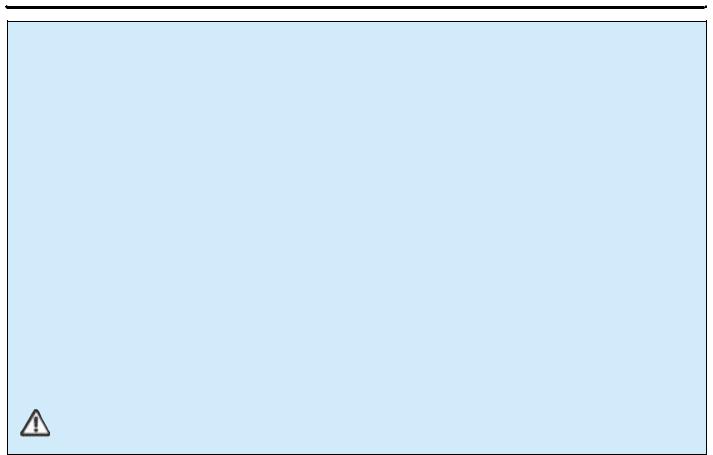
104
PRACTICAL INFORMATION
ACCESSORIES FOR YOUR PARTNER
For your PEUGEOT only use accessories and original parts approved by the manufacturer.
These accessories and parts are all adapted to your PEUGEOT, after being tested and approved for reliability and safety, which PEUGEOT cannot guarantee for other products.
A wide choice of original accessories, approved by PEUGEOT, is available through the dealer network. They all carry the PEUGEOT guarantee.
– Safety |
: Separation grille, window protectors, anti-theft alarm, wheel locks, parking assistance, |
|
signalling triangle, first aid kit, fog lamps, safety jacket... |
– Comfort |
: Rear and side windows, audio-telephone console, covers compatible with side air bags, |
|
mats, luggage net, door deflectors... |
– Loading |
: Roof bars, thermoformed interior protectors, wooden interior fittings, loading roller... |
– Communication |
: Audio systems, audio-telephone, speakers, CD changer, navigation system... |
– Customising |
: Alloy wheels, door sills, mud flaps, ... |
– Leisure |
: Tow bar, roof bars, snow chains, tailgate bicycle carrier... |
– Children |
: Booster seats and child seats... |
– Maintenance products : Screenwash, interior and exterior maintenance and cleaning products...
Before installing any electrical accessory on your vehicle, contact a PEUGEOT dealer.
 22-12-2003
22-12-2003

107
TECHNICAL DATA
CONSUMPTION
|
|
|
In accordance with directive 99/100 in M.P.G. (litres/100 km) |
|||
Engine |
Gearbox |
Model |
Urban driving |
Inter- |
Mixed |
Emission of |
|
codes |
|
|
urban |
|
CO2 by weight |
|
|
|
|
|
|
(g/km) |
|
|
|
|
|
|
|
1.1 litre |
Manual |
GBHFXB |
– |
– |
– |
– |
1.4 litre |
Manual |
GBKFWB |
29.1 (9.7) |
45.6 (6.2) |
37.6 (7.5) |
175 |
|
|
GCKFWB |
|
|
|
|
1.9 litre Diesel |
Manual |
GBWJYB/K |
32.1 (8.8) |
49.6 (5.7) |
40.9 (6.9) |
181 |
|
|
GCWJYB PLC |
|
|
|
|
2 litre Turbo HDI |
Manual |
GBRHYB |
39.2 (7.2) |
57.6 (4.9) |
49.6 (5.7) |
152 |
|
|
GCRHYB |
|
|
|
|
|
|
|
|
|
|
|
Fuel consumption values correct at time of printing.
 22-12-2003
22-12-2003

108
TECHNICAL DATA
WEIGHTS AND TOWING LOADS (IN KG)
Engine |
1.1 litre |
|
|
|
|
1.4 litre |
|
|
Model |
600 kg |
|
|
600 kg |
|
|
800 kg |
|
Gearbox |
Manual |
|
|
Manual |
|
|
Manual |
|
Model codes |
GBHFXB |
|
|
GBKFWB |
|
GCKFWB |
||
• Kerb weight |
1 108 |
|
|
1 108 |
|
|
1 110 |
|
• Gross vehicle |
|
|
|
|
|
|
|
|
weight (GVW) |
1 690 |
|
|
1 690 |
|
|
1 890 |
|
• Gross train weight (GTW)* |
2 440 |
|
|
2 590 |
|
|
2 790 |
|
• Unbraked trailer |
500 |
|
|
500 |
|
|
500 |
|
• Braked trailer (within GTW) |
750 |
|
|
900 |
|
|
900 |
|
• Recommended nose weight |
– |
|
|
– |
|
|
– |
|
|
|
|
|
|
|
|
|
|
|
|
|
|
|
|
|
|
|
Engine |
1.9 litre D |
|
|
2 litre Turbo HDI |
||||
Model |
600 kg |
800 kg |
|
|
600 kg |
800 kg |
||
Gearbox |
Manual |
Manual |
|
|
Manual |
Manual |
||
Model codes |
GBWJYB/K |
GCWJYB PLC |
|
GBRHYB |
GCRHYB |
|||
• Kerb weight |
1 163 |
1 225 |
|
|
1 211 |
|
1 211 |
|
• Gross vehicle |
|
|
|
|
|
|
|
|
weight (GVW) |
1 755 |
1 955 |
|
|
1 790 |
|
1 990 |
|
• Gross train weight (GTW)* |
2 855 |
3 055 |
|
|
2 890 |
|
3 090 |
|
• Unbraked trailer |
500 |
500 |
|
|
500 |
|
– |
|
• Braked trailer (within GTW) |
1 100 |
1 100 |
|
|
1 100 |
|
– |
|
• Recommended nose weight |
– |
|
– |
|
|
– |
– |
|
|
|
|
|
|
|
|
|
|
* In the case of a towing vehicle, the speed is limited to 60 mph (100 km/h).  22-12-2003
22-12-2003
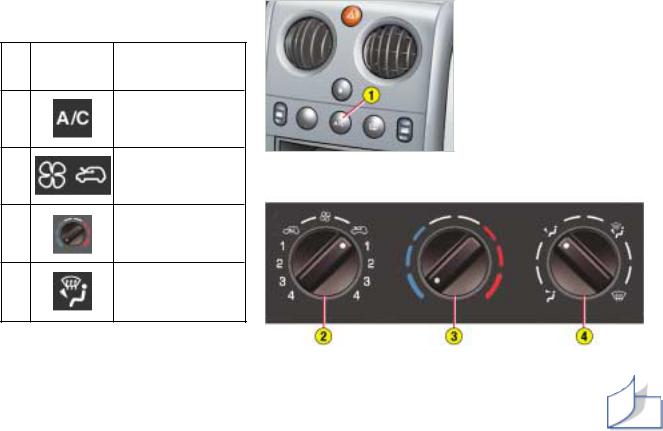
YOUR PARTNER AT A GLANCE |
11 |
|
|
AIR CONDITIONING
N° |
Symbol |
Function |
1
Air conditioning control.
2
Air flow adjustment and air intake control.
3 |
Temperature |
|
adjustment. |
||
|
4
Air distribution adjustment.
50
 22-12-2003
22-12-2003
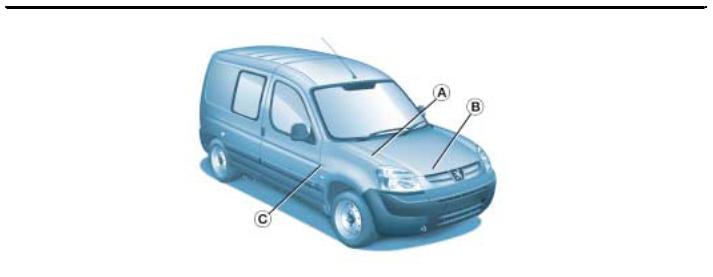
111
TECHNICAL DATA
THE IDENTIFICATION FEATURES OF YOUR PARTNER
A.Manufacturer's plate (under the bonnet, on the front right wing).
B.Serial number on the bodywork (under the bonnet, on the right-hand crossmember).
C.Tyres and paint colour reference.
The label C on the driver's door pillar, near the hinges, gives:
–the wheel and tyre sizes,
–the tyre pressures: (tyre pressure checks must be carried out cold, at least every month),
–the paint colour reference.
 22-12-2003
22-12-2003
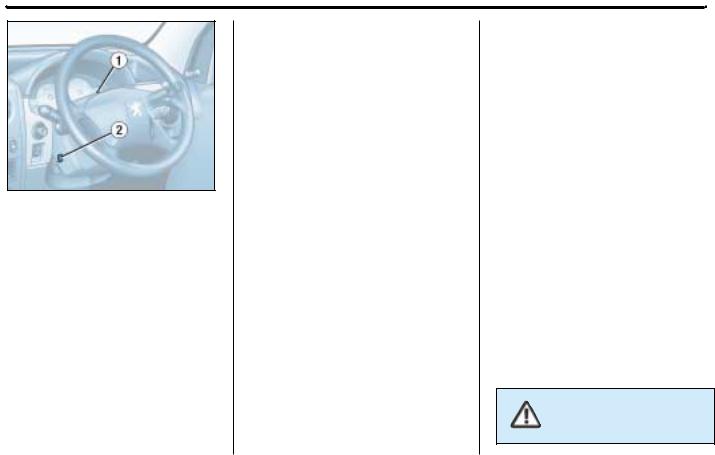
112
SPECIAL FEATURES
THE ALARM SYSTEM*
The alarm offers two types of protection:
•exterior protection: the alarm sounds if a door, the boot or the bonnet is opened;
•interior protection: the alarm sounds if there is a variation in the volume inside the vehicle (breaking of a window or movement inside the vehicle).
Setting the alarm
Switch the ignition off and get out of the vehicle.
Activate the alarm within five minutes following your exit from the vehicle, by locking using the remote control key (the red indicator light on the switch 1, which can be seen from the outside, flashes once a second).
 22-12-2003
22-12-2003
When the alarm is triggered, the siren sounds and the direction indicators flash for thirty seconds.
After it has been triggered, the alarm becomes operational again.
Note: if you wish to lock your vehicle without setting the alarm, lock it using the lock.
Warning key in the door
If, on setting the alarm, a door, the boot or the bonnet are not closed correctly, the siren sounds for a moment.
Close the vehicle correctly to set the alarm.
If the interior protection alarm is triggered ten times in succession, it is disarmed automatically. It must be set again in order for it to operate correctly.
Disarming the alarm
Unlock the vehicle using the remote control key (the red indicator light on the switch 1 goes out).
Note: if the warning light flashes, it is a sign that the alarm has been triggered in your absence.
To stop it, switch on the ignition.
* According to destination.
Note: when the alarm is set, but the remote control no longer works:
unlock the doors using the key and open the door; the alarm is triggered;
switch the ignition on within ten seconds; the alarm is disarmed.
To set the alarm with exterior protection only.
If, while you are away from the vehicle, you wish to leave a window partially open or a pet inside the vehicle, you need to select exterior protection only:
•Switch off the ignition.
•Press the button 2 until the light 1 comes on continuously.
•Get out of the vehicle.
•Press the locking button of the remote control.
•The doors lock.
•The red light on the switch flashes once a second.
Malfunction
When the ignition is switched on, fixed lighting of the red indicator light, located in the centre of the fascia, indicates a siren connection fault.
Contact a PEUGEOT dealer to have the system checked.
Do not make any modifications to the alarm system.
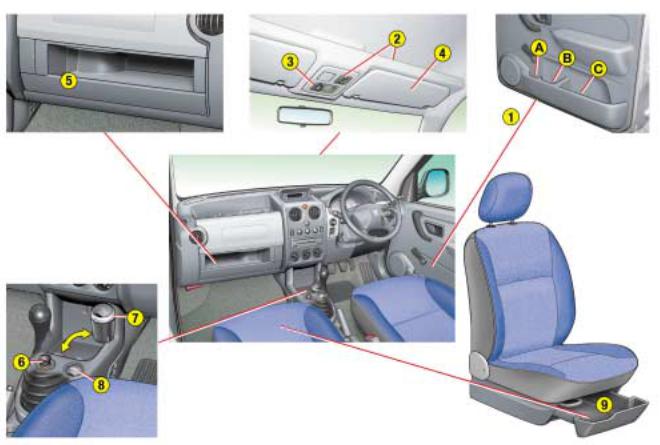
12 |
YOUR PARTNER AT A GLANCE |
|
|
 22-12-2003
22-12-2003

YOUR PARTNER AT A GLANCE |
13 |
|
|
FRONT FITTINGS
1.STORAGE COMPARTMENTS IN THE DOORS
A.Bottle holder.
B.Can holder.
C.Storage compartment.
2.OVERHEAD STORAGE WITH MAP READING LIGHT
3.COURTESY LIGHT
4.SUN VISORS
5.GLOVE BOX
To open the glove box with lid, lift the handle (version with air conditioning).
6.LIGHTER
7.REMOVABLE ASHTRAY
Lift the lid to open the ashtray.
To empty it, after opening, remove it by pulling upwards.
8.12 V ACCESSORIES SOCKET
This is located at the bottom of the centre console.
It permits the connection of a telephone charger, a baby's bottle warmer, ...
9.STORAGE DRAWER
To open it, lift it slightly and pull it forwards.
79
 22-12-2003
22-12-2003

14 |
YOUR PARTNER AT A GLANCE |
|
|
OPENING THE BONNET
FILLING WITH FUEL
This operation must be carried out with the engine switched off.
Insert the key then turn it to the left.
Remove the cap.
An indication shows which type of fuel to use.
When you fill your tank, do not continue after the third cut-off of the pump. This could cause a malfunction.
The capacity of the tank is approximately 55 litres for petrol engines and 60 litres for Diesel engines.
Note: the right-hand sliding side door cannot be opened while the fuel tank cap is removed.
Inside the vehicle: Pull the control on the left-hand side, under the fascia panel.
Low fuel level warning light
From the time this light comes on, you have enough fuel left to cover approximately 30 miles (50 km).
 22-12-2003
22-12-2003
|
Outside the vehicle: |
|
|
|
Lift the control, raise the |
|
|
|
bonnet |
and secure the |
|
70 |
strut to keep the bonnet |
69 |
|
open. |
|
||

18
PEUGEOT SERVICING
PEUGEOT SERVICING
Your vehicle benefits from extended service intervals.
•For petrol engines: every 20,000 miles (30 000 km) or every two years.
•For direct injection diesel engines: every 12,000 miles (20 000 km) or every two years.
•For indirect injection diesel engines: every 10,000 miles (15 000 km) or every two years.
Your service indicator informs you when a service is due; the point at which a service is due is calculated from the last indicator zero reset (see corresponding section).
This point is determined by two parameters:
–the distance travelled,
–the time elapsed since the last service.
Note: the distance remaining may be weighted by the time factor, depending on the driver's style of driving.
The extension of the service intervals means that the engine oil level must be checked regularly: topping up of the oil between oil changes is normal.
This is why the PEUGEOT network is offering you an intermediate service between regular services.
The date of this visit is not shown by the service indicator. It is to be carried out at least every 10,000 miles (15 000 km) for petrol engines; every 6,000 miles (10 000 km) for direct injection diesel engines and every 5,000 miles (7 500 km) for indirect injection diesel engines.
A PEUGEOT dealer will carry out a quick check and top up the levels if necessary (oil, coolant, windscreen wash up to 2 litres).
If the oil level is too low there is a risk of serious damage to the engine: check the engine oil level at least every 2,000 to 3,000 miles (3 000 to 5 000 km), depending on the conditions of use.
This extended servicing has been made possible by modifications to our vehicles and to the lubricants:
THUS IT IS ESSENTIAL TO USE ONLY LUBRICANTS WHICH ARE SUITED TO YOUR ENGINE AND RECOMMENDED BY THE MANUFACTURER (see "Lubricants" pages).
 22-12-2003
22-12-2003
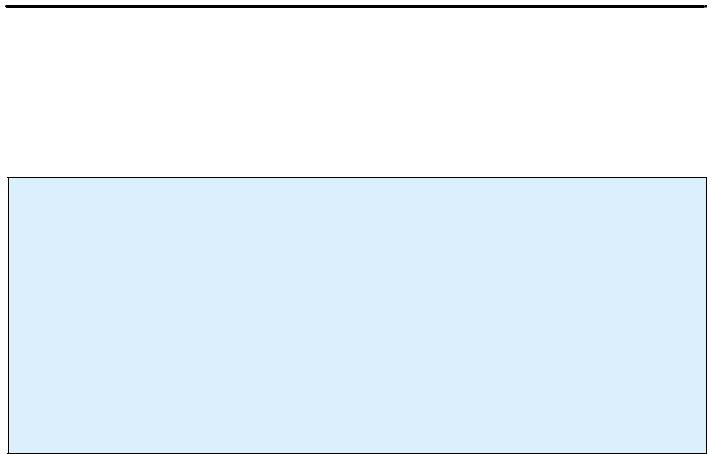
19
PEUGEOT SERVICING
SPECIAL FEATURES
Some of your vehicle's vital components have specific servicing schedules.
The brake fluid must be replaced every 36,000/40,000 miles (60 000 km) or every 2 years.
The passenger compartment filter must be checked at each visit to the PEUGEOT dealer (intermediate visits and regular services).
The timing belt: consult your PEUGEOT dealer.
Arduous conditions of use
If the vehicle is used in certain particularly arduous conditions:
•Continuous door-to-door use.
•Town use (e.g. taxi).
•Repeated short journeys, with the engine cold in low temperatures.
Or in long stays in the following conditions:
•Hot countries with temperatures often above 30 °C.
•Cold countries with temperatures often below minus 15 °C.
•Countries with a dusty atmosphere.
•Countries whose lubricants or fuels do not conform to our recommendations.
It is necessary to follow an "Arduous Conditions" servicing schedule, which includes special operations and shorter service intervals:
•Every 12,000 miles (20 000 km) or every year for petrol engine vehicles.
•Every 10,000 miles (15 000 km) or every year for Direct Injection Diesel engine vehicles.
•Every 6,000 miles (10 000 km) or every year for Indirect Injection Diesel engine vehicles.
 22-12-2003
22-12-2003
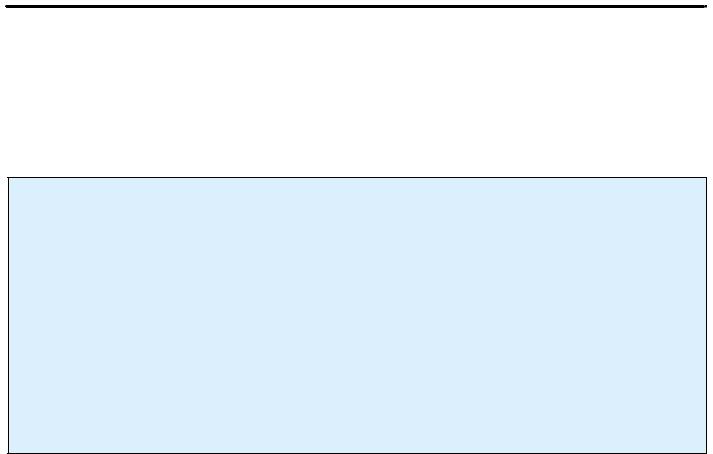
19
PEUGEOT SERVICING
SPECIAL FEATURES
Some of your vehicle's vital components have specific servicing schedules.
The brake fluid must be replaced every 36,000/40,000 miles (60 000 km) or every 2 years.
The passenger compartment filter must be checked at each visit to the PEUGEOT dealer (intermediate visits and regular services).
The timing belt: consult your PEUGEOT dealer.
Arduous conditions of use
If the vehicle is used in certain particularly arduous conditions:
•Continuous door-to-door use.
•Town use (e.g. taxi).
•Repeated short journeys, with the engine cold in low temperatures.
Or in long stays in the following conditions:
•Hot countries with temperatures often above 30 °C.
•Cold countries with temperatures often below minus 15 °C.
•Countries with a dusty atmosphere.
•Countries whose lubricants or fuels do not conform to our recommendations.
It is necessary to follow an "Arduous Conditions" servicing schedule, which includes special operations and shorter service intervals:
•Every 12,000 miles (20 000 km) or every year for petrol engine vehicles.
•Every 10,000 miles (15 000 km) or every year for Direct Injection Diesel engine vehicles.
•Every 6,000 miles (10 000 km) or every year for Indirect Injection Diesel engine vehicles.
 22-12-2003
22-12-2003
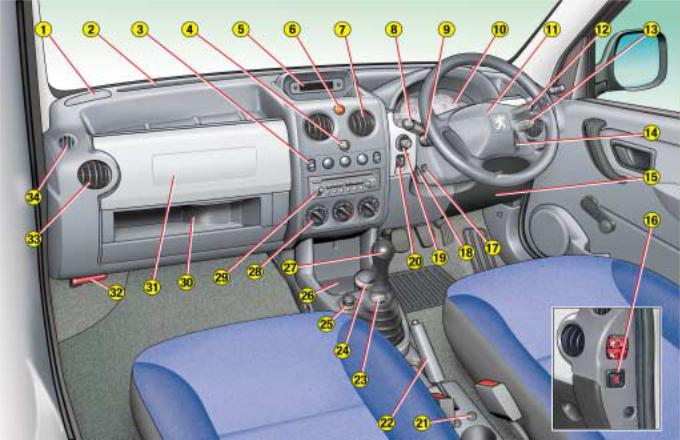
2 |
YOUR PARTNER AT A GLANCE |
|
|
 22-12-2003
22-12-2003
YOUR PARTNER AT A GLANCE |
3 |
|
|
1 - Speaker (tweeter).
2 - Windscreen demisting vents.
3 - Controls:
–Electric windows.
–Demisting of rear door windows or tailgate.
–Air conditioning.
4 - Central locking button.
5 - Multifunction display or clock.
6 - Hazard lights button.
7 - Central adjustable heating/ventilation vents.
8 - Lights and direction indicators stalk.
9 - Cruise control.
10 - Instrument panel.
11 - Driver's air bag. Horn.
12 - Windscreen wash-wipe stalk.
13 - Audio equipment steering wheel control.
14 - Steering lock and ignition.
 22-12-2003
22-12-2003
15 |
- Fuse box. |
32 - Bonnet release. |
16 |
- Passenger air bag |
33 - Side adjustable heating/ |
|
disarming control*. |
ventilation vents. |
17 |
- Alarm. |
34 - Side window |
18 |
- Steering wheel adjustment |
de-icing/demisting vents. |
|
||
|
control. |
|
19 |
- Passenger's electric mirror |
|
|
control. |
|
20 |
- Headlamp height |
|
|
adjustment. |
|
21 |
- Heated seats control. |
|
22 |
- Handbrake. |
|
23 |
- 12 V accessories socket. |
|
24 |
- Removable ashtray. |
|
25 |
- Lighter. |
|
26 |
- Storage. |
|
27 |
- Gear lever. |
|
28 |
- Heating/air conditioning |
|
|
controls. |
|
29 |
- Audio RB3 or RD3. |
|
30 |
- Lower glove box. |
|
31 |
- Upper glove box or |
* According to destination. |
|
passenger air bag. |
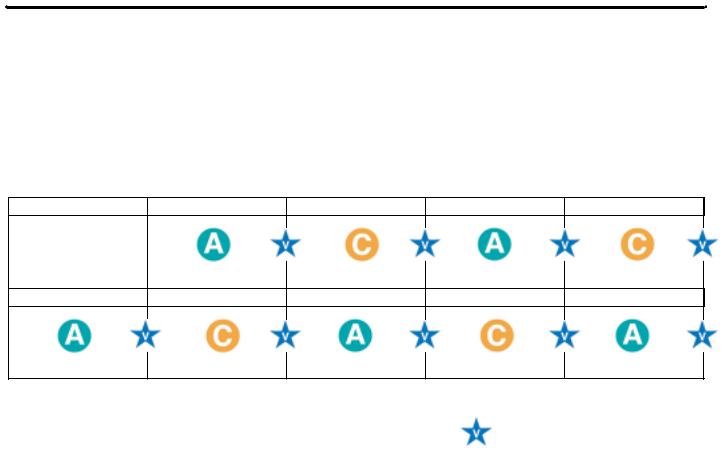
22
PEUGEOT SERVICING
TYPES OF SERVICE
Each vehicle has its own servicing cycle, based upon the engine type.
This cycle consists of alternating two types of service, A and C, intermediate visits and a few additional operations depending on your vehicle; these correspond to key stages in the life of your vehicle.
When the first service is carried out and at each subsequent service, your dealer will advise you of the type and content of the next service due.
THE MAINTENANCE CYCLE FOR YOUR PARTNER PETROL
Service every 20,000 miles (30,000 km) or 2 years.
MILES (KM) |
20,000 (30,000) |
40,000 (60,000) |
60,000 (90,000) |
80,000 (120,000) |
1st service at 6,000 miles (10,000 km)
or 6 months*.
This is necessary in order to benefit from the warranty.
100,000 (150,000) |
120,000 (180,000) |
140,000 (210,000) |
160,000 (240,000) |
180,000 (270,000) |
These services are carried out with synthetic based oil; Fuel Economy oil or synthetic oil may also be used.
Arduous conditions of use (see corresponding section).
* Whichever comes first.
 22-12-2003
22-12-2003
Intermediate top-up visit included in the Fixed Services.
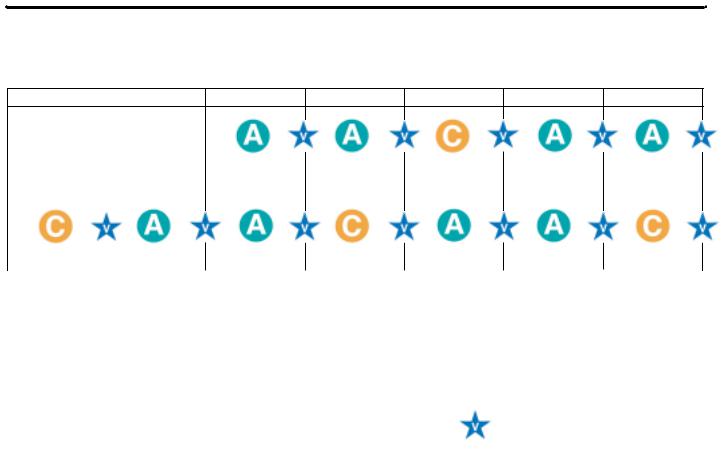
23
PEUGEOT SERVICING
THE MAINTENANCE CYCLE FOR YOUR PARTNER TURBO DIESEL HDI
Service every 12,000 miles (20,000 km) or 2 years.
MILES (KM) |
12,000 (20,000) 24,000 (40,000) 36,000 (60,000) 48,000 (80,000) 60,000 (100,000) |
1st Service at 6,000 miles (10,000 km)
or 6 months*.
This is necessary in order to benefit from the warranty.
72,000 (120,000) |
84,000 (140,000) |
96,000 (160,000) |
108,000 (180,000) |
120,000 (200,000) |
132,000 (220,000) |
144,000 (240,000) |
|
|
|
|
|
|
|
|
|
|
|
|
|
|
These services are carried out with synthetic based oil; Fuel Economy oil or synthetic oil may also be used. Arduous conditions of use (see corresponding section).
Intermediate top-up visit included in the Fixed Services.
* Whichever comes first.
 22-12-2003
22-12-2003
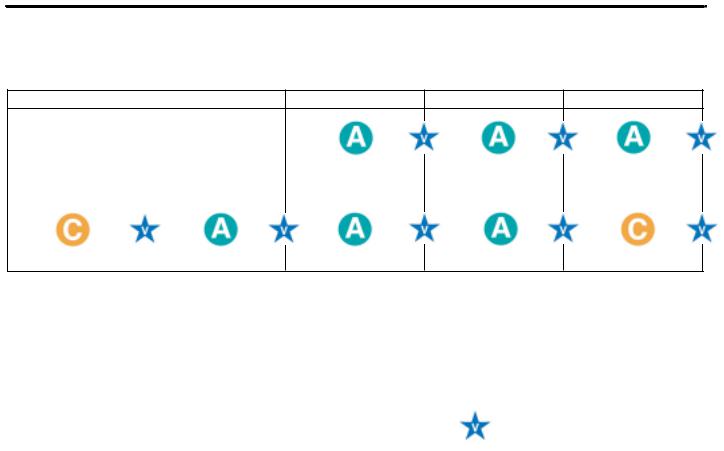
24
PEUGEOT SERVICING
THE MAINTENANCE CYCLE FOR YOUR PARTNER INDIRECT INJECTION DIESEL
Service every 10,000 miles (15,000 km) or 2 years.
MILES (KM) |
10,000/90,000 (15,000/135,000) |
20,000/100,000 (30,000/150,000) |
30,000/110,000 (45,000/165,000) |
1st Service at 6,000 miles (10,000 km) or 6 months*.
This is necessary in order to benefit from the warranty.
40,000/120,000 (60,000/180,000) |
50,000/130,000 (75,000/195 000) |
60,000/140,000 (90,000/210,000) |
70,000/150,000 (105,000/225,000) |
80,000/160,000 (120,000/240,00) |
|
|
|
|
|
|
|
|
|
|
These fixed services are carried out with synthetic based oil; Fuel Economy oil or synthetic oil may also be used. Arduous conditions of use (see corresponding section).
Intermediate top-up visit included in the Fixed Services.
* Whichever comes first.
 22-12-2003
22-12-2003
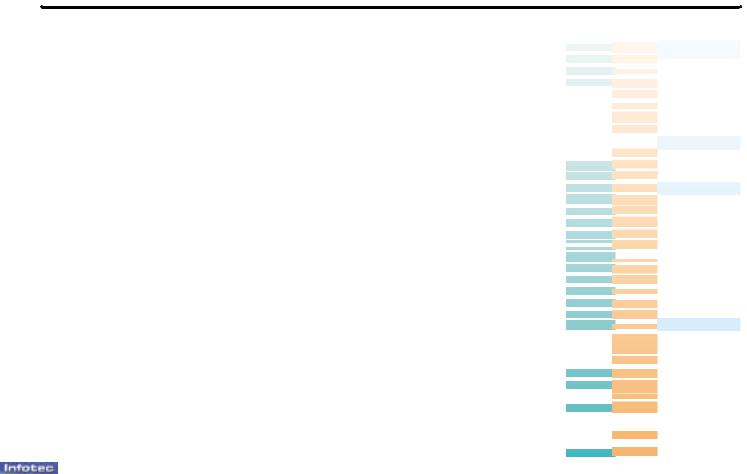
25
PEUGEOT SERVICING
A AND C SERVICE LEVELS AND THE INTERMEDIATE VISIT
Operations |
Description of operation |
1st service |
|
Level |
|
|
|
|
A |
C |
Intermediate |
|
– Engine oil |
|
|
|
|
DRAIN/REFILL |
|
|
|
||
|
|
|
|
|
|
– Bleed fuel filter (diesel) |
|
|
|
|
|
|
|
||||
|
– Oil filter |
|
|
|
|
|
– Petrol filter (according to engine) |
|
|
|
|
REPLACE |
|
|
|
|
|
– Diesel filter or element (according to engine) |
|
|
|
|
|
|
|
|
|
||
|
– Air filter element |
|
|
|
|
|
|
|
|
|
|
|
– Spark plugs (petrol) |
|
|
|
|
|
– Engine oil (check + top-up) |
|
|
|
|
|
|
|
|||
|
– Manual gearbox oil (check + top-up) |
|
|
|
|
|
– Battery (check + top-up) if cap is removable |
|
|
|
|
LEVEL |
|
|
|
|
|
– Screen wash (check + top-up) |
|
|
|
|
|
|
– Coolant (check + top-up) |
|
|
|
|
|
|
||||
|
– Brake fluid (check + top-up) |
|
|
|
|
|
– Power steering fluid (check + top up according to specification) |
|
|
|
|
|
|
|
|
||
|
– Operation of lights and indicators |
|
|
|
|
|
|
||||
|
– Condition of glass, headlamp and light lenses and mirrors |
|
|
|
|
|
– Horn |
|
|
|
|
|
|
|
|
|
|
|
|
|
|
|
|
|
|
|
|
|
|
|
– Windscreen washer jets |
|
|
|
|
|
– Condition of wiper blades |
|
|
|
|
|
– Condition and tension of the ancillary drive belts |
|
|
|
|
|
|
|
|
|
|
|
– Handbrake |
|
|
|
|
|
|
|
|
|
|
CHECK |
– Condition of hydraulic circuits (hoses and covers) |
|
|
|
|
– Condition of rubber boots and gaiters |
|
|
|
|
|
|
|
|
|||
|
– Brake pads |
|
|
|
|
|
|
|
|||
|
– Play in hubs, link rods, ball joints, flexible mountings |
|
|
|
|
|
|
|
|
|
|
|
– Shock absorbers |
|
|
|
|
|
|
|
|
|
|
|
– Rear drum brake lining wear |
|
|
|
|
|
|
|
|
|
|
|
– Condition and pressure of tyres (including spare wheel) |
|
|
|
|
|
– Emission control check as per current legislation (petrol) |
|
|
|
|
|
– Smoke opacity (diesel) |
|
|
|
|
|
|
|
|
|
|
|
– Passenger compartment filter (according to specification) |
|
|
|
|
|
– Visual check of the whole vehicle |
|
|
|
|
|
|
|
|
|
|
SERVICE* |
– Courtesy vehicle |
|
|
|
|
|
|
|
|
|
|
ROAD TEST |
|
|
|
|
|
|
|
|
|
|
|
|
|
|
|
|
|
22-12-2003 : All driving conditions. |
: Arduous conditions. |
* According to destination. |
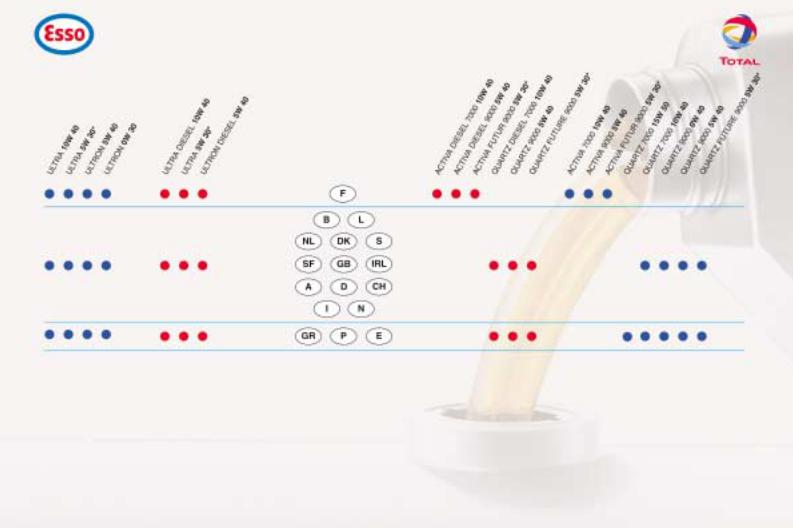
26
TRADE NAMES OF RECOMMENDED ENGINE LUBRICANTS IN EUROPE(1)
P E T R O L D I E S E L D I E S E L P E T R O L
(1) Minimum quality standard: Petrol engines: ACEA A3 and API SH/SJ; Diesel engines: ACEA B3 and API CF/CD. ACEA = Association des Constructeurs Européens Automobiles (Association of European Automobile Manufacturers) - API = American Petroleum Institute.
If oil is used which does not conform to the ACEA A3-B3 standards, this requires the "Arduous Conditions" servicing schedule to be followed, which involves shorter intervals between services.
* This Fuel Economy oil can only be used in engines designed for its use.
 22-12-2003
22-12-2003
